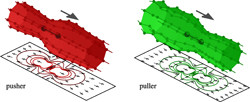Microrobot swimming styles
Not all swimmers have the same motion or gait. Moreover, the type of microenvironment will affect variables such as velocity and direction. In the context of microrobots that can accurately deliver drugs, controllability is extremely important. The 'Microswimmer environments: modelling, control and tailoring' (MICROENVS) project has brought together experts in soft-matter physics and hydrodynamics to model the effects of microswimmers on the dynamics of their environments and vice versa. Variables included different swimming gaits and their interaction with passive objects, such as filaments and elastic boundaries. Microrobots, like microorganisms, swim in a low-Reynolds-number regime, requiring swimming methods that differ from macroscale swimmers. MICROENVS researchers have developed a hydrodynamic model of a low-Reynolds number swimmer that describes circular trajectories. This can serve as a template for artificial microrobots that perform transport and pumping tasks. Microbes use a variety of organelles like flagella for motility. Flagellates and ciliated algae produce dipolar flow fields and the researchers developed a model to predict their interaction with rigid and elastic boundaries. Results shed light on the way that swimmer motility is affected under confinement and the motion of bacteria in vivo. The researchers also modelled motion of polymer chains under confinement. This is relevant to the way in which biopolymers are able to cross the cell wall and to advanced techniques for the sorting of DNA. Also developed is a system to develop rectification devices that sort swimmers according to their swimming gait. Yet another, models the dynamics of many particles in suspension. These include the collective motion of swimmers, and their interaction with extended objects. Follow-up to the project will consist mainly of using the numerical algorithms developed to study the dynamics of various swimmers in confinement, as well as their interaction with polymer bushes and the swimming environments encountered by bacteria in the body. Interaction of swimmers with complex environments is a wide-ranging field incorporating areas that can be barely imagined right now. At present, the field is open for research from diagnostics and drug delivery to biofuel production using algae.





